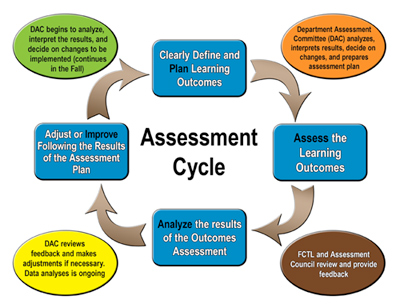How to Continually Analyze Assessment and Performance Data
Assessment Plan Documents MSU Public Affairs Mission Assessment Plan Instructional Webinar
Assessment is a constant cycle of improvement. Data gathering is ongoing. The goal of assessment, whether for an academic department or a program, is to provide: (a) a clear conceptualization of intended student learning outcomes, (b) a description of how these outcomes are assessed and measured, (c) a description of the results obtained from these measures, and (d) a description of how these results validate current practices or point to changes needed to improve student learning.
Academic departments or programs need to constantly ask: What do we want students to be able to know, do, and appreciate and how do we know that students are achieving the intended learning outcomes? After implementing an assessment plan and measuring student learning outcomes, departments, programs, and units need to analyze the results obtained and use those results to make necessary changes or improvements to the unit or program.
Before beginning, it is important to have the proper structure in place to ensure that the process, once in place, is self-sustaining. For this reason, it will be recommended that each department forms a Departmental Assessment Committee (DAC), which will ideally be comprised of at least one representative from each program. Members of the DAC would understand the purpose and importance of assessment and would be willing to share their knowledge, expertise, and interest in assessment with other faculty members in their department. To alleviate faculty workload on the DAC, a rotating chair model can be implemented. The assessment work and process is more likely to become part of the University culture if faculty collectively buy into the assessment procedures, agree on the important learning outcomes, ways to measures these outcomes, what the data suggest, and what the results mean for program improvement.
The Four Steps of the Assessment Cycle

Step 1: Clearly define and identify the learning outcomes
Each program should formulate between 3 and 5 learning outcomes that describe what students should be able to do (abilities), to know (knowledge), and appreciate (values and attitudes) following completion of the program. The learning outcomes for each program will include Public Affairs learning outcomes addressing community engagement, cultural competence, and ethical leadership.
Step 2: Select appropriate assessment measures and assess the learning outcomes
Multiple ways of assessing the learning outcomes are usually selected and used. Although direct and indirect measures of learning can be used, it is usually recommended to focus on direct measures of learning. Levels of student performance for each outcome is often described and assessed with the use of rubrics.
It is important to determine how the data will be collected and who will be responsible for data collection. Results are always reported in aggregate format to protect the confidentiality of the students assessed.
Step 3: Analyze the results of the outcomes assessed
It is important to analyze and report the results of the assessments in a meaningful way. A small subgroup of the DAC would ideally be responsible for this function. The assessment division of the FCTL would support the efforts of the DAC and would provide data analysis and interpretation workshops and training.
Step 4: Adjust or improve programs following the results of the learning outcomes assessed
Assessment results are worthless if they are not used. This step is a critical step of the assessment process. The assessment process has failed if the results do not lead to adjustments or improvements in programs. The results of assessments should be disseminated widely to faculty in the department in order to seek their input on how to improve programs from the assessment results. In some instances, changes will be minor and easy to implement. In other instances, substantial changes will be necessary and recommended and may require several years to be fully implemented.
Source: https://www.missouristate.edu/Assessment/the-assessment-process.htm
Post a Comment for "How to Continually Analyze Assessment and Performance Data"